brake light YAMAHA MT-07 2014 Owners Manual
[x] Cancel search | Manufacturer: YAMAHA, Model Year: 2014, Model line: MT-07, Model: YAMAHA MT-07 2014Pages: 106, PDF Size: 3.29 MB
Page 6 of 106

TABLE OF CONTENTSSAFETY INFORMATION.................. 1-1
DESCRIPTION .................................. 2-1
Left view ......................................... 2-1
Right view ....................................... 2-2
Controls and instruments ............... 2-3
INSTRUMENT AND CONTROL
FUNCTIONS ...................................... 3-1
Immobilizer system......................... 3-1
Main switch/steering lock............... 3-2
Indicator lights and warning lights............................................ 3-3
Multi-function meter unit ................ 3-6
Handlebar switches ...................... 3-13
Clutch lever .................................. 3-14
Shift pedal .................................... 3-14
Brake lever.................................... 3-14
Brake pedal .................................. 3-15
ABS (for ABS models) .................. 3-15
Fuel tank cap ................................ 3-16
Fuel ............................................... 3-17
Fuel tank breather hose and
overflow hose ............................ 3-18
Catalytic converter ....................... 3-19
Seats ............................................ 3-19
Helmet holding cable.................... 3-21
Storage compartment .................. 3-22
Adjusting the shock absorber assembly ................................... 3-23
Luggage strap holders ................. 3-24 Sidestand ...................................... 3-24
Ignition circuit cut-off system ....... 3-25
Auxiliary DC connector ................. 3-27
FOR YOUR SAFETY –
PRE-OPERATION CHECKS ............. 4-1
OPERATION AND IMPORTANT
RIDING POINTS ................................ 5-1
Starting the engine .......................... 5-1
Shifting ............................................ 5-2
Tips for reducing fuel consumption ................................ 5-3
Engine break-in ............................... 5-3
Parking ............................................ 5-4
PERIODIC MAINTENANCE AND
ADJUSTMENT ................................... 6-1
Owner’s tool kit ............................... 6-2
Periodic maintenance chart for the emission control system .............. 6-3
General maintenance and lubrication chart ........................... 6-4
Checking the spark plugs ............... 6-8
Engine oil and oil filter cartridge...... 6-9
Coolant.......................................... 6-11
Replacing the air filter element and cleaning the check hose..... 6-14
Checking the throttle grip free
play ............................................ 6-15
Valve clearance ............................. 6-15 Tires .............................................. 6-15
Cast wheels .................................. 6-18
Adjusting the clutch lever free
play ............................................ 6-18
Checking the brake lever free
play ............................................ 6-19
Brake light switches ..................... 6-19
Checking the front and rear brake pads .......................................... 6-20
Checking the brake fluid level ...... 6-21
Changing the brake fluid .............. 6-22
Drive chain slack........................... 6-22
Cleaning and lubricating the drive chain.......................................... 6-24
Checking and lubricating the cables ........................................ 6-25
Checking and lubricating the
throttle grip and cable ............... 6-25
Checking and lubricating the brake and shift pedals............... 6-25
Checking and lubricating the brake and clutch levers ............. 6-26
Checking and lubricating the
sidestand................................... 6-27
Lubricating the rear suspension ... 6-27
Lubricating the swingarm pivots......................................... 6-27
Checking the front fork ................. 6-28
Checking the steering................... 6-28
Checking the wheel bearings ....... 6-29
Battery .......................................... 6-29U1WSE0E0.book Page 1 Wednesday, November 13, 2013 10:28 AM
Page 7 of 106

TABLE OF CONTENTS
Replacing the fuses .......................6-31
Replacing the headlight bulb.........6-32
Tail/brake light ...............................6-34
Replacing a turn signal light bulb ............................................6-34
Replacing the license plate light bulb ............................................6-35
Replacing the auxiliary light
bulb ............................................6-36
Supporting the motorcycle............6-36
Front wheel (for non-ABS models).................6-37
Rear wheel (for non-ABS models).................6-39
Troubleshooting ............................6-41
Troubleshooting charts .................6-42
MOTORCYCLE CARE AND
STORAGE ..........................................7-1
Matte color caution .........................7-1
Care .................................................7-1
Storage ............................................7-3
SPECIFICATIONS ..............................8-1
CONSUMER INFORMATION ............9-1
Identification numbers .....................9-1
INDEX ...............................................10-1
U1WSE0E0.book Page 2 Wednesday, November 13, 2013 10:28 AM
Page 14 of 106
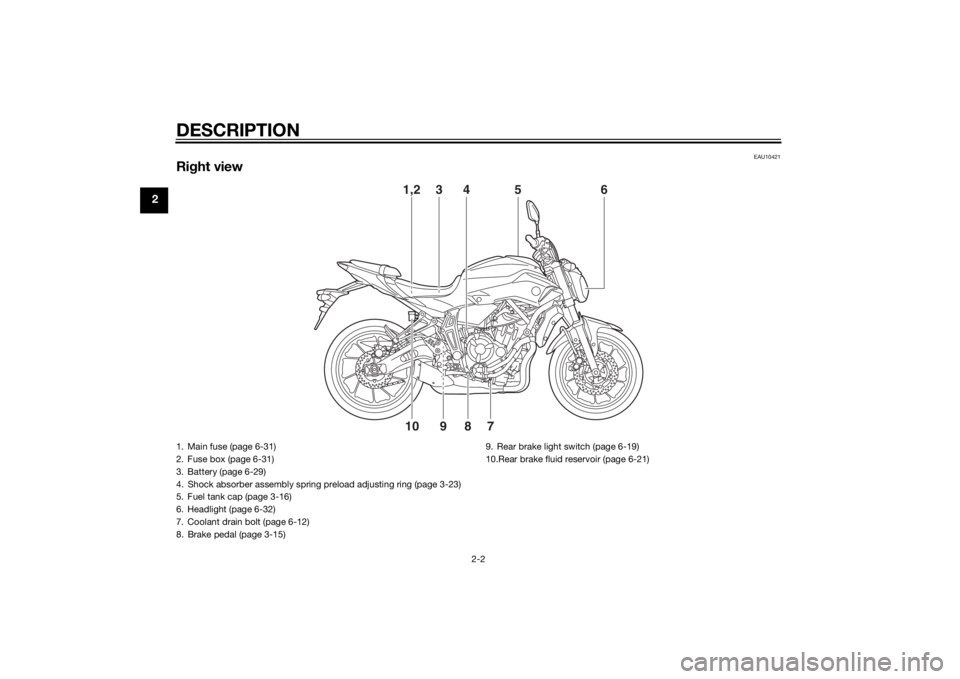
DESCRIPTION
2-2
2
EAU10421
Right view
7
8
9
101,2
3
4
6
5
1. Main fuse (page 6-31)
2. Fuse box (page 6-31)
3. Battery (page 6-29)
4. Shock absorber assembly spring preload adjusting ring (page 3-23)
5. Fuel tank cap (page 3-16)
6. Headlight (page 6-32)
7. Coolant drain bolt (page 6-12)
8. Brake pedal (page 3-15) 9. Rear brake light switch (page 6-19)
10.Rear brake fluid reservoir (page 6-21)U1WSE0E0.book Page 2 Wednesday, November 13, 2013 10:28 AM
Page 18 of 106
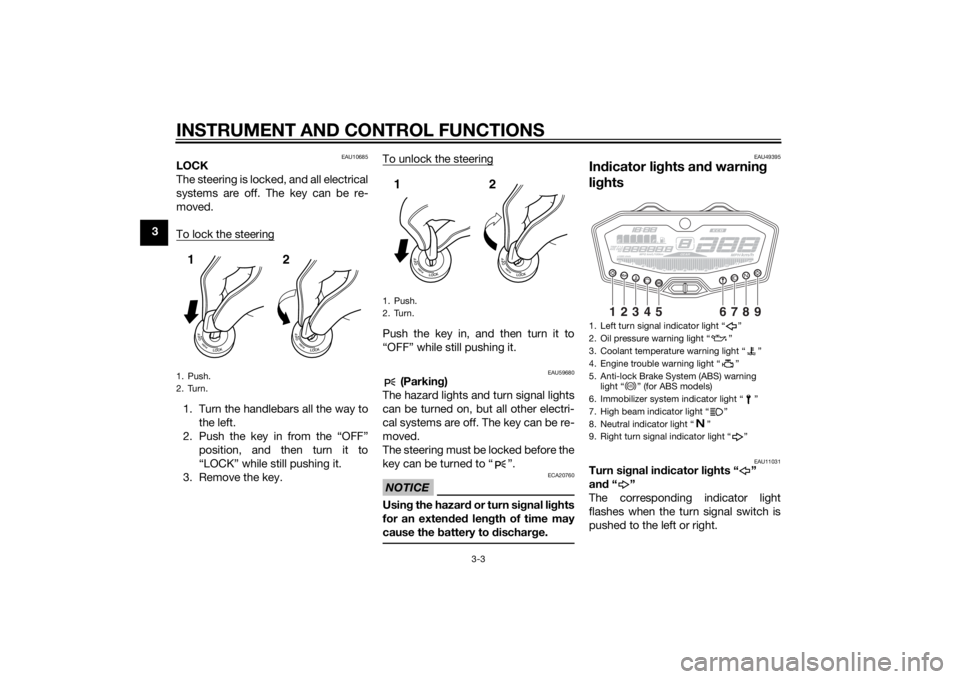
INSTRUMENT AND CONTROL FUNCTIONS
3-3
3
EAU10685
LOCK
The steering is locked, and all electrical
systems are off. The key can be re-
moved.
To lock the steering1. Turn the handlebars all the way tothe left.
2. Push the key in from the “OFF” position, and then turn it to
“LOCK” while still pushing it.
3. Remove the key. To unlock the steering
Push the key in, and then turn it to
“OFF” while still pushing it.
EAU59680
(Parkin
g)
The hazard lights and turn signal lights
can be turned on, but all other electri-
cal systems are off. The key can be re-
moved.
The steering must be locked before the
key can be turned to “ ”.
NOTICE
ECA20760
Usin g the hazar d o r t ur n s i gnal li ghts
for an exten ded len gth of time may
cause the battery to d ischarge.
EAU49395
In dicator li ghts an d warnin g
li g hts
EAU11031
Turn si gnal in dicator li ghts “ ”
an d“”
The corresponding indicator light
flashes when the turn signal switch is
pushed to the left or right.
1. Push.
2. Turn.12
1. Push.
2. Turn.12
1. Left turn signal indicator light “ ”
2. Oil pressure warning light “ ”
3. Coolant temperature warning light “ ”
4. Engine trouble warning light “ ”
5. Anti-lock Brake System (ABS) warning light “ ” (for ABS models)
6. Immobilizer system indicator light “ ”
7. High beam indicator light “ ”
8. Neutral indicator light “ ”
9. Right turn signal indicator light “ ”
1
2
3
4
5
6
7
8
9
ABS
U1WSE0E0.book Page 3 Wednesday, November 13, 2013 10:28 AM
Page 20 of 106
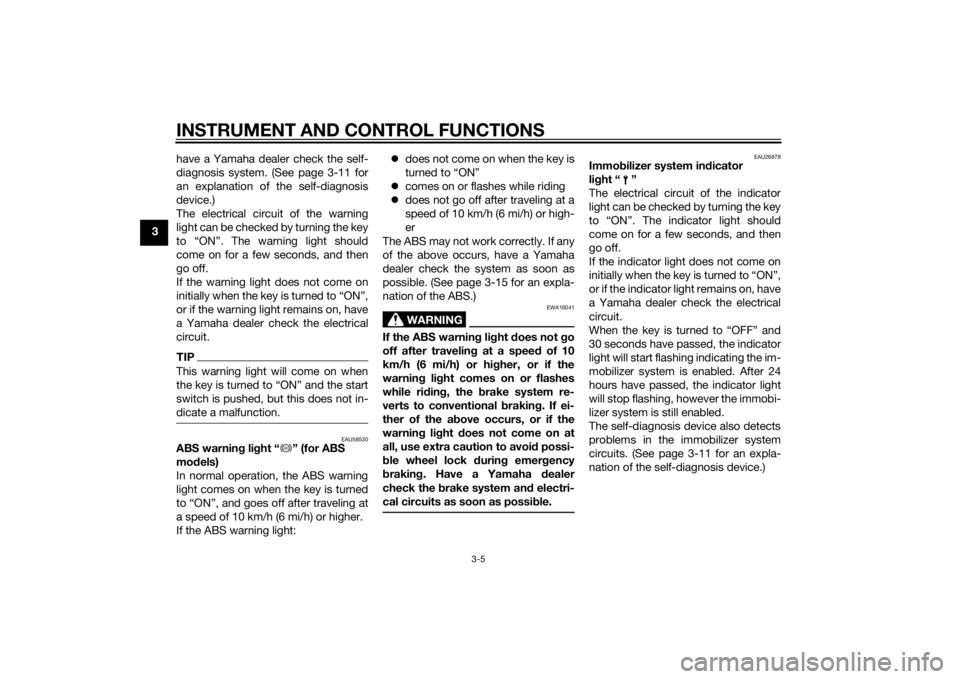
INSTRUMENT AND CONTROL FUNCTIONS
3-5
3have a Yamaha dealer check the self-
diagnosis system. (See page 3-11 for
an explanation of the self-diagnosis
device.)
The electrical circuit of the warning
light can be checked by turning the key
to “ON”. The warning light should
come on for a few seconds, and then
go off.
If the warning light does not come on
initially when the key is turned to “ON”,
or if the warning light remains on, have
a Yamaha dealer check the electrical
circuit.
TIPThis warning light will come on when
the key is turned to “ON” and the start
switch is pushed, but this does not in-
dicate a malfunction.
EAU58530
ABS warning light “ ” (for ABS
models)
In normal operation, the ABS warning
light comes on when the key is turned
to “ON”, and goes off after traveling at
a speed of 10 km/h (6 mi/h) or higher.
If the ABS warning light:
does not come on when the key is
turned to “ON”
comes on or flashes while riding
does not go off after traveling at a
speed of 10 km/h (6 mi/h) or high-
er
The ABS may not work correctly. If any
of the above occurs, have a Yamaha
dealer check the system as soon as
possible. (See page 3-15 for an expla-
nation of the ABS.)
WARNING
EWA16041
If the ABS warning light does not go
off after traveling at a speed of 10
km/h (6 mi/h) or higher, or if the
warning light comes on or flashes
while riding, the brake system re-
verts to conventional braking. If ei-
ther of the above occurs, or if the
warning light does not come on at
all, use extra caution to avoid possi-
ble wheel lock during emergency
braking. Have a Yamaha dealer
check the brake system and electri-
cal circuits as soon as possible.
EAU26878
Immobilizer system indicator
light “ ”
The electrical circuit of the indicator
light can be checked by turning the key
to “ON”. The indicator light should
come on for a few seconds, and then
go off.
If the indicator light does not come on
initially when the key is turned to “ON”,
or if the indicator light remains on, have
a Yamaha dealer check the electrical
circuit.
When the key is turned to “OFF” and
30 seconds have passed, the indicator
light will start flashing indicating the im-
mobilizer system is enabled. After 24
hours have passed, the indicator light
will stop flashing, however the immobi-
lizer system is still enabled.
The self-diagnosis device also detects
problems in the immobilizer system
circuits. (See page 3-11 for an expla-
nation of the self-diagnosis device.)
ABS
U1WSE0E0.book Page 5 Friday, December 27, 2013 2:28 PM
Page 30 of 106

INSTRUMENT AND CONTROL FUNCTIONS
3-15
3
EAU12942
Brake pedalThe brake pedal is on the right side of
the motorcycle. To apply the rear
brake, press down on the brake pedal.
EAU60020
ABS (for ABS mo dels)The Yamaha ABS (Anti-lock Brake
System) features a dual electronic con-
trol system, which acts on the front and
rear brakes independently.
Operate the brakes with ABS as you
would conventional brakes. If the ABS
is activated, a pulsating sensation may
be felt at the brake lever or brake ped-
al. In this situation, continue to apply
the brakes and let the ABS work; do
not “pump” the brakes as this will re-
duce braking effectiveness.
WARNING
EWA16051
Always keep a sufficient distance
from the vehicle ahea d to match the
ri din g spee d even with ABS.
The ABS performs best with
lon g b rakin g d istances.
On certain surfaces, such as
rou gh or g ravel roa ds, the b rak-
in g d istance may b e longer with
the ABS than without.The ABS is monitored by an ECU,
which will revert the system to conven-
tional braking if a malfunction occurs.
TIP The ABS performs a self-diagno-
sis test each time the vehicle first
starts off after the key is turned to
“ON” and the vehicle has traveled
at a speed of 10 km/h (6 mi/h) or
higher. During this test, a “click-
ing” noise can be heard from the
hydraulic control unit, and if the
brake lever or brake pedal is even
slightly applied, a vibration can be
felt at the lever and pedal, but
these do not indicate a malfunc-
tion.
This ABS has a test mode which
allows the owner to experience
the pulsation at the brake lever or
brake pedal when the ABS is op-
erating. However, special tools are
required, so please consult your
Yamaha dealer when performing
this test.
1. Brake pedal
1
U1WSE0E0.book Page 15 Wednesday, November 13, 2013 10:28 AM
Page 68 of 106
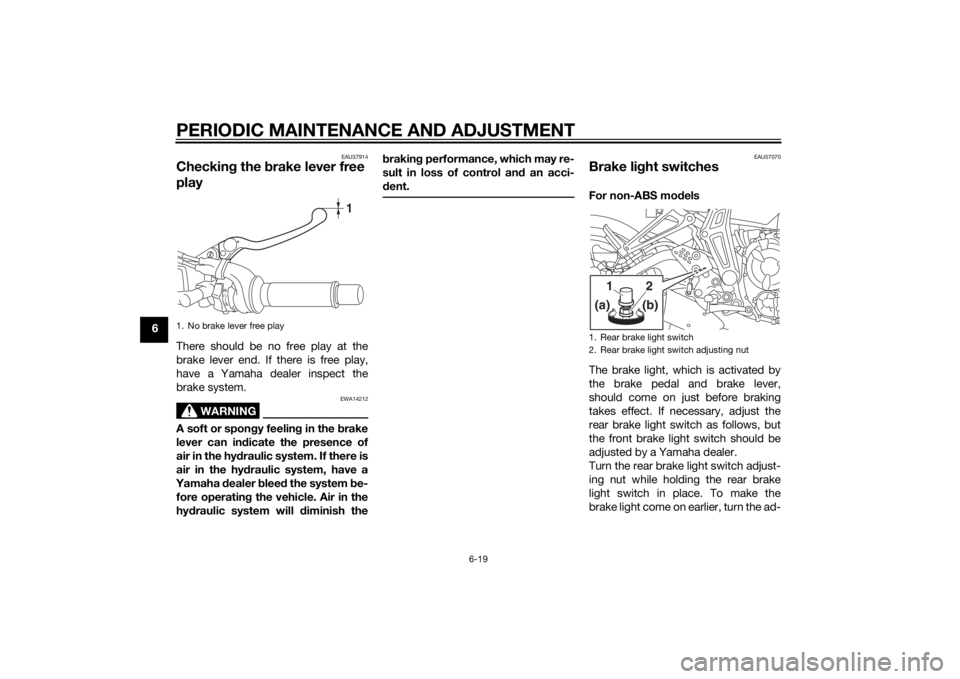
PERIODIC MAINTENANCE AND ADJUSTMENT
6-19
6
EAU37914
Checking the brake lever free
playThere should be no free play at the
brake lever end. If there is free play,
have a Yamaha dealer inspect the
brake system.
WARNING
EWA14212
A soft or spon gy feelin g in the b rake
lever can in dicate the presence of
air in the hy draulic system. If there is
air in the hy draulic system, have a
Yamaha dealer blee d the system be-
fore operatin g the vehicle. Air in the
hy draulic system will diminish the b
rakin g performance, which may re-
sult in loss of control and an acci-
d ent.
EAU57070
Brake li ght switchesFor non-ABS mo dels
The brake light, which is activated by
the brake pedal and brake lever,
should come on just before braking
takes effect. If necessary, adjust the
rear brake light switch as follows, but
the front brake light switch should be
adjusted by a Yamaha dealer.
Turn the rear brake light switch adjust-
ing nut while holding the rear brake
light switch in place. To make the
brake light come on earlier, turn the ad-
1. No brake lever free play
1
1. Rear brake light switch
2. Rear brake light switch adjusting nut
1
2
(b)
(a)
U1WSE0E0.book Page 19 Wednesday, November 13, 2013 10:28 AM
Page 69 of 106

PERIODIC MAINTENANCE AND ADJUSTMENT
6-20
6
justing nut in direction (a). To make the
brake light come on later, turn the ad-
justing nut in direction (b).
For ABS mo
dels
The brake light, which is activated by
the brake pedal and brake lever,
should come on just before braking
takes effect. If necessary, have a
Yamaha dealer adjust the brake light switches.
EAU22393
Checkin g the front an d rear
b rake pa dsThe front and rear brake pads must be
checked for wear at the intervals spec-
ified in the periodic maintenance and
lubrication chart.
EAU36891
Front brake pad s
Each front brake pad is provided with
wear indicators, which allows you to
check the brake pad wear without hav-
ing to disassemble the brake. To check
the brake pad wear, check the position
of the wear indicators while applying
the brake. If a brake pad has worn to
the point that a wear indicator almost touches the brake disc, have a
Yamaha dealer replace the brake pads
as a set.
EAU46292
Rear
brake pa ds
Each rear brake pad is provided with
wear indicator grooves, which allow
you to check the brake pad wear with-
out having to disassemble the brake.
To check the brake pad wear, check
the wear indicator grooves. If a brake
pad has worn to the point that a wear
indicator groove almost appears, have
a Yamaha dealer replace the brake
pads as a set.
1. Brake pad wear indicator
1
1
1. Brake pad wear indicator groove
1
1
U1WSE0E0.book Page 20 Wednesday, November 13, 2013 10:28 AM
Page 83 of 106
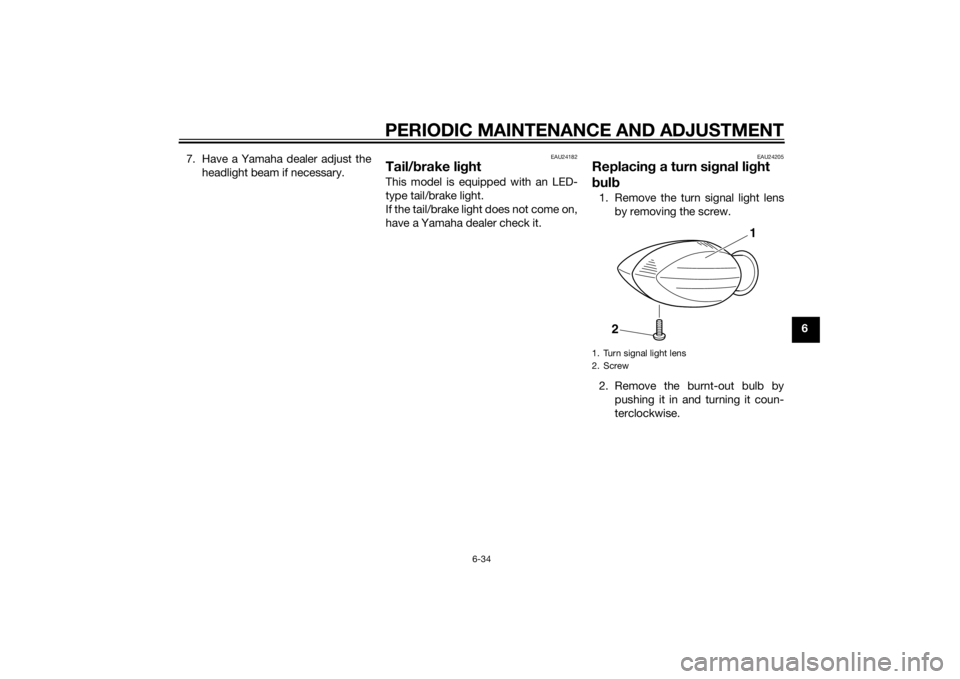
PERIODIC MAINTENANCE AND ADJUSTMENT
6-34
6
7. Have a Yamaha dealer adjust the
headlight beam if necessary.
EAU24182
Tail/b rake li ghtThis model is equipped with an LED-
type tail/brake light.
If the tail/brake light does not come on,
have a Yamaha dealer check it.
EAU24205
Replacin g a turn sig nal light
b ul b1. Remove the turn signal light lens
by removing the screw.
2. Remove the burnt-out bulb by pushing it in and turning it coun-
terclockwise.1. Turn signal light lens
2. Screw
1
2
U1WSE0E0.book Page 34 Wednesday, November 13, 2013 10:28 AM
Page 88 of 106

PERIODIC MAINTENANCE AND ADJUSTMENT
6-39
6
EAU44802
Rear wheel (for non-ABS
models)
WARNING
EWA14841
For the ABS mo del, have a Yamaha
d ealer remove an d install the wheel.
EAU59940
To remove the rear wheel
WARNING
EWA10822
To avoi d injury, securely support the
vehicle so there is no dan ger of it
fallin g over.1. Loosen the locknut and drive
chain slack adjusting nut on each
side of the swingarm.
2. Loosen the axle nut. 3. Lift the rear wheel off the ground
according to the procedure on
page 6-36.
4. Remove the axle nut and the drive chain slack adjusting plate.
5. Push the wheel forward, and then remove the drive chain from the
rear sprocket.
TIPIf the drive chain is difficult to re-
move, remove the wheel axle first,
and then lift the wheel upward
enough to remove the drive chain
from the rear sprocket.
The drive chain does not need to
be disassembled in order to re-
move and install the rear wheel.6. While supporting the brake caliper
and slightly lifting the wheel, pull
the wheel axle out and remove the
drive chain slack adjusting plate.
1. Drive chain slack adjusting plate
2. Drive chain slack adjusting nut
3. Locknut
4. Axle nut
1
2
3
4
U1WSE0E0.book Page 39 Wednesday, November 13, 2013 10:28 AM